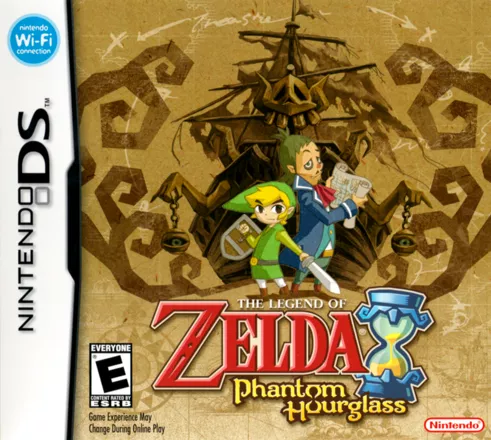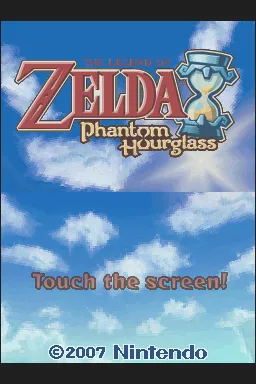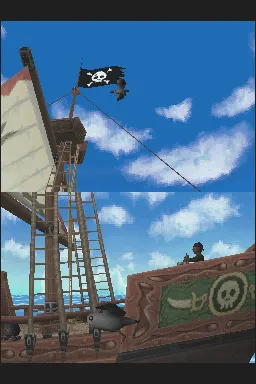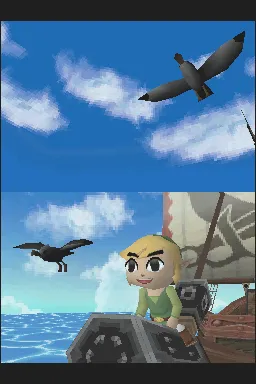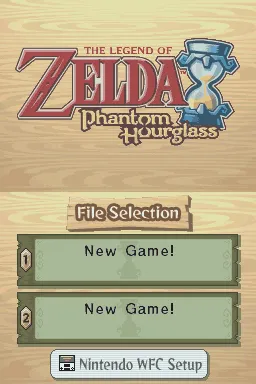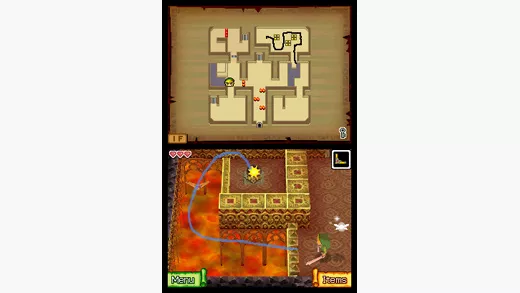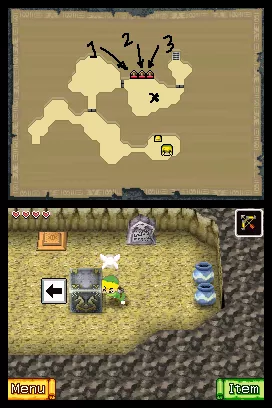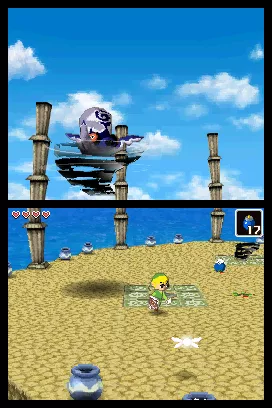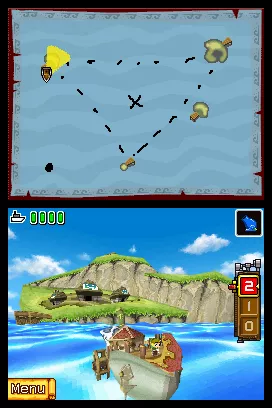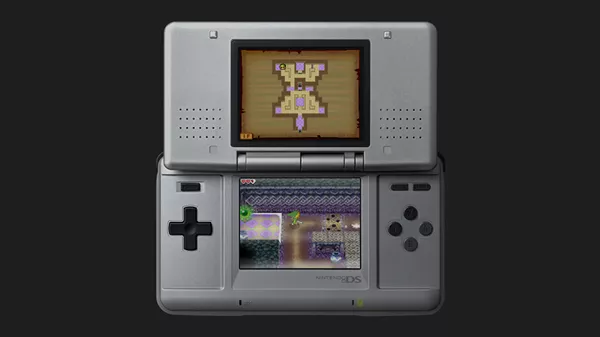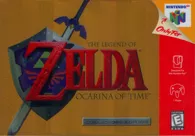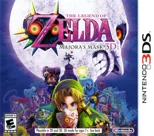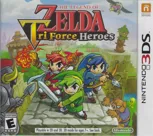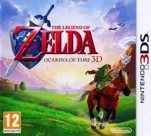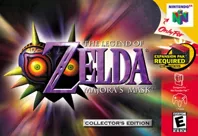The Legend of Zelda: Phantom Hourglass
Description official descriptions
The Legend of Zelda arrives on the Nintendo DS with The Legend of Zelda: Phantom Hourglass. This game starts off where the Wind Waker for the GameCube ended. Link, his friend Tetra and her gang of pirates are sailing unexplored seas when they come across a ghost ship. When Tetra wants to explore the ship she disappears and Link, who goes after her, falls into the sea and becomes stranded on an unknown island.
While remaining true to the traditional Legend of Zelda formula, this game's controls are drastically different from other Zelda titles. This time you only use the touch screen to make Link move and attack instead of buttons. For example, swinging your sword is done with a short line horizontally or vertically in front of Link, or by tapping on a specific enemy. Link can somersault forward by having the player draw a small circle on the edge of the screen while running. The boomerang can be thrown in a specific path by drawing its exact route on the touch screen.
You can also use the touch screen to make notes of secret treasures and items on the map simply by writing them down. Sailing across the sea is also done by simply drawing the route on the map. While the route is being traveled, the player can pan the screen around to look out for enemies and other obstacles. The ship's route can also be changed while traveling if something else catches the player's attention. Later on, the player can even go fishing in the sea, using the stylus to pull the rod and reel in their catch.
The game is presented in the same cel-shaded style as the Wind Waker but it is displayed from a classic top-down perspective.
Spellings
- ゼルダの伝説 夢幻の砂時計 - Japanese spelling
- 젤다의 전설 몽환의 모래시계 - Korean spelling
Groups +
Screenshots
Promos
Videos
See any errors or missing info for this game?
You can submit a correction, contribute trivia, add to a game group, add a related site or alternate title.
Credits (Nintendo DS version)
94 People (84 developers, 10 thanks) · View all
| Director | |
| Sub Director | |
| Planning | |
| Programming Lead | |
| Map Programming | |
| Object Programming | |
| Player Programming | |
| Enemy Programming | |
| NPC Programming | |
| Ship Programming | |
| UI System Programming | |
| Wireless Programming | |
| Design Lead | |
| Player Design | |
| Enemy Design | |
| NPC Design | |
| Map/Object Design | |
| [ full credits ] | |
Reviews
Critics
Average score: 88% (based on 109 ratings)
Players
Average score: 3.8 out of 5 (based on 70 ratings with 4 reviews)
The Good
The Phantom Hourglass once again proves that Nintendo can make excellent games which make the most of their consoles. It is perfectly tuned to the DS's capabilities and turns the stylus and touch-screen into a fantastic control mechanism. This is the main way of playing the game, using a clever indirect control mechanism of moving a fairy character who Link follows. Further swipes and circles and Link draws his sword and slashes, making fighting fun as you enact combat moves. It all feels so natural it is a wonder not all DS games are so easy to control.
The story is a direct sequel to the Wind Waker, which may be because of the graphical style. The simple cell-shaded characters transfer well to the DS and create crisp, clean worlds that are beautiful to look at, especially at sea.
The plot is dense and as with all recent Zelda games it has a certain plot device to it. This time it's boats, again like the Wind Waker except without the sailing. Once again you appear in a mysterious land which is under the grip of some terrible evil and Link must travel from one island to another sequentially freeing them. This he does with the aid of his trusty steamboat and its rather conniving captain. The boat is customisable and you'll find yourself carrying out many side-quests to power up the vessel and fight off marauding pirates.
The second literal plot device is the titular Phantom Hourglass. Early on you discover the entrance to a subterranean world which must be conquered to save the land, except your time down there is limited by the amount of sand in your hourglass. To spend more time in the dungeon you must liberate the islands, turning their captors into sand. Of course some of the items needed to liberate the islands are in the dungeon, and so the gentle back-and-forth unravelling of the plot happens.
The Bad
It is this unravelling that really is a solid games undoing. Whilst the control system is good and graphics excellent, the game is just too long. I got bored with the side-quests and endless to-and-fro-ing of the islands. It started off feeling like exploration but towards the end just made me feel the developers were milking it.
This is especially true of the end, I don't think I've ever played a game with such a long finale. I breathed a sigh of relief when I saw the credits and knew it was finally over.
The Bottom Line
This is a rock solid accessible light RPG that is a pleasure to control. It is fluid and has been created to showcase the strengths of the DS which it does well. The plot is interesting though fairly standard for a Zelda game. I just wish they hadn't made it so long.
Nintendo DS · by RussS (807) · 2011
Fun little game that makes great use of the DS
The Good
Visually this game is its bright and colourful with great animations on all the characters. There is some good level design here. The music is good too. Surprisingly this game made me laugh a few times here and there too. The game is almost all controlled with the touch screen and it works well. Without giving away too much you can do some things like slash the stylus across an enemy to hit with the sword and draw a path that you want the boomerang to fly in.
The Bad
Rather than a traditional world map, this game has the player sailing an ocean and going onto various islands. It is not terrible, but I would rather be on dry land. There is one Dungeon that you have to revisit several times during the game. I wish that you could complete an area once and just move on.
The Bottom Line
Like nearly all other Zelda games, this game is a great adventure from start to finish. Complete with hunting down pieces of heart, finding cool new items to use, and salvaging the ocean floor for treasure. Recommended to anyone with a Nintendo DS.
Nintendo DS · by Matthew Melbourne (18) · 2009
Incorporates brilliant touch innovation in classic Zelda gameplay. Get it!
The Good
This game has awesome graphics. The same style as the Wind Waker (to which this game is a sequel) is used. While there are some polygons taken out and some things are simplified for the small screen, the charming cell-shaded style holds up surprisingly well, making it one of the better looking DS titles.
The story of Phantom Hourglass picks up right were Wind Waker left off. Link and his friend Tetra (who is actually princess Zelda) come across a ghost ship. Tetra is taken away by the Ghost Ship so Link goes after her but falls into the sea. When he awakes, he finds himself on an island. Here he meets Ceila the fairy, who is like Navi in Ocarina of Time. This is the start of one of the most unique titles in the Zelda franchise.
When you start the game you will discover that the D-pad isn't used to control Link. You have use the DS' touch screen instead. Actually, everything is done on the touch screen. While this may sound a bit controversial at first, when you try it for a few minutes, you will find controlling Link is a breeze. Walking is done by sliding the stylus across the screen. Where you touch, Ceila will go, and Link will follow her. When touching close to link he will walk slower. Attacking, talking and manipulating enemies, characters and things is done by simply touching them. Quickly draw a line in the direction of an enemy to stab it. Run and draw a small circle at the edge of the screen to roll. When you draw a circle around Link, he does his famous spin attack. You will understand this within five minutes and it makes the game much more accessible for both Zelda fans and newcomers. But the touch implementation is used for other things in many brilliant ways. The most notable ones are the way you draw your route on the Sea Chart. In Wind Waker Sailing at sea was boring, with little to do on trips that could take minutes. This was of the biggest flaws in that game. In this game, however, you just draw your route and off you go. There are plenty of hazards to meet and other ships to board, as well as some uncharted islands to find. While the map is smaller than in Wind Waker, the islands are also closer to each other so you usually get where you want to go in less than two minutes. Another important use of the lower screen is the notation of clues. When you find a clue, you can just switch the dungeon map to the bottom screen and write your clue down, making it easy to remember. Find a route you need to take when sailing through foggy weather? Need to remember the order of switches in that particular dungeon room? Just draw it or write it down on the map. This is used in many fun and exciting new ways that I will leave you to find out for yourself. Using items is also very easy with touch controls. Want to make your boomerang go a special route? Just select it and draw the route on the touch screen. Want to place a bomb? Just tap where you want to drop it and it drops down exactly where you want it. Most of these touch controls work very well and they all make perfect sense.
This game has some great characters. The aforementioned Ceila is a somewhat bold but helpful Fairy. Besides Ceila there is Oshus, who is, in typical Zelda tradition, the 'wise old man' in this game. Then there's Linebeck, a Jack Sparrow-like sailor more interested in precious treasures than saving the damsel in distress. Linebeck is cowardly and a bit rude but he will take you across the many different islands. These are the main characters but there are dozens more and everyone you meet has his or her own characteristics. Like in Wind Waker, the characters are extremely expressive, making them much more attractive to the player and a delight to look at, even on the small screen.
As always, the dungeons are a delight and to complete them, you need to find new items to solve puzzles and defeat certain enemies. Although similar to the ones seen in previous Zelda titles, the innovative controls make all-new puzzles possible. For example, there's a door. There is no way to open it and no keyhole to put a key in. But wait! There is that strange symbol you found in another room that you wrote down. When you write it on the door, it opens. This is an example of many moments that you will notice the control scheme does really add a lot of depth to the game. At the end of each dungeon there is a boss that you need to fight. All of these bosses are a lot of fun and make use of the touch screen controls in different and fun ways. Another important addition in the dungeon/overworld structure is the Temple of the Ocean King. this is a dungeon you will have to revisit multiple times during the game. There is a life sucking curse in this temple that slowly draws your hearts. After a while you get an item that protects you: The Phantom Hourglass. Once all the sand is in the lower part of the Hourglass, however, you are no longer protected. Luckily, you can find extra sand after beating bosses or finding it in secret places. In this temple there are various safe zones that stop the time and make you invisible for the Phantoms; unbeatable knight-like spirits that guard the temple from intruders. This makes for a fun and exciting stealth game. Once you get more items, you can get through earlier floors easier and you will be able to go deeper into the dungeon. At the end of the game you will be able to easily reach the lowest floor where so you can reach the last boss. This dungeon really is a fun addition to the gameplay as well as the storyline.
Music is epic and you will want to put your headphones on. Sound effects are classic Zelda effects, like the puzzles solving sound, but are crisp, clear and up to date. When you are in a dungeon or cave, you hear echoes, adding to the atmosphere.
Although short, Phantom Hourglass has plenty of stuff to do besides the main game, such as finding ship parts to customize Linebeck's steamship and finding secret treasures.
The Bad
Rolling doesn't always work out as fine as other actions.
This game is too short and easy compared to some other Zelda games such as A Link to the Past, Ocarina of Time and Twilight Princess. You will probably finish it in about fifteen hours. It feels somewhat like the creators felt that the new and unexplored control scheme had to be compromised by making the game easier. But the controls work out well enough for a more challenging game than this. There is a decent amount of replay value but it still is a shame. You just wish there was more to this great game.
The temple of the Ocean King has only one save point halfway through the dungeon, forcing you to do a lot of floors over and over. Although they are easier than before because of newly acquired items, it still is annoying if you want to save precious time for lower floors. One or two extra save points would have been nice.
The Bottom Line
A brilliant blend of classic Zelda gameplay and innovative touch screen-controls that will keep you hooked for hours. One of the best Nintendo DS titles so far!
Nintendo DS · by Rensch (203) · 2007
Trivia
1001 Video Games
The Legend of Zelda: Phantom Hourglass appears in the book 1001 Video Games You Must Play Before You Die by General Editor Tony Mott.
Awards
- GamePro
- February 2008 (Issue #223) - Best Handheld Game of 2007
- GamePro (Germany)
- March 28, 2008 - Best Handheld Game in 2007 (Readers' Vote)
- GameSpy
- 2007 – #10 Game of the Year
- 2007 – Handheld Game of the Year
- 2007 – Nintendo DS Game of the Year
- 2007 – Nintendo DS Game of the Year (Readers' Vote)
- 2007 – Nintendo DS Action Game of the Year
- Golden Joystick Awards
- 2008 - Bliss Handheld Game of the Year
Information also contributed by Big John WV.
Analytics
Upgrade to MobyPro to view research rankings and price history! (when applicable)
Related Sites +
-
The Legend of Zelda – Phantom Hourglass
The official game web site by Nintendo of America. -
UHS - The Legend of Zelda: Phantom Hourglass Hints
Shows hints gradually, so your game isn't spoiled.
Identifiers +
Contribute
Are you familiar with this game? Help document and preserve this entry in video game history! If your contribution is approved, you will earn points and be credited as a contributor.
Contributors to this Entry
Game added by Rensch.
Wii U added by Michael Cassidy.
Additional contributors: Alaka, gamewarrior, Cantillon, Jason Strautman, Patrick Bregger, Grandy02, piltdown_man, FatherJack.
Game added October 6, 2007. Last modified November 5, 2023.


